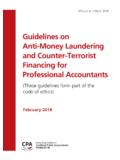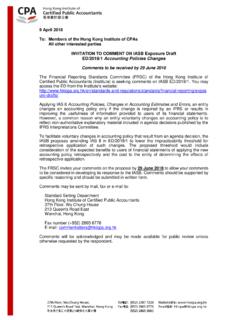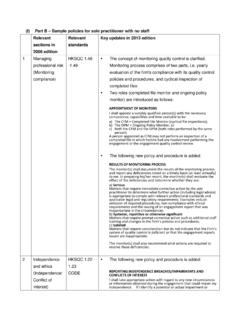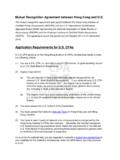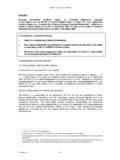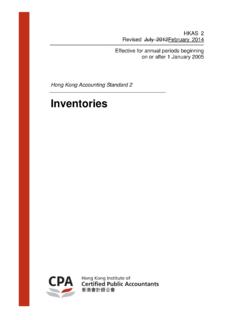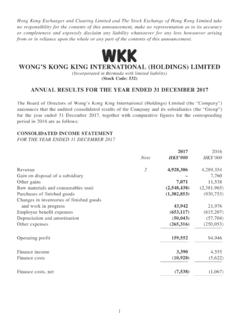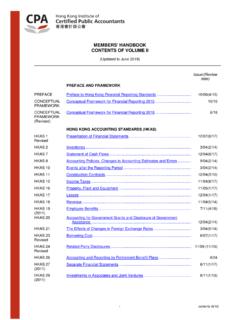Transcription of HKFRS 15 Revenue from Contracts with Customers
1 HKFRS 15 Revenue from Contracts with Customers HKICPA Standard Setting Department Staff Summary (July 2014) This HKICPA Standard Setting Department Staff Summary is intended for general guidance only. This Staff Summary has not been reviewed by the HKICPA Financial Reporting Standards Committee. The HKICPA and its staff DO NOT accept any responsibility or liability, and DISCLAIM all responsibility and liability, in respect of the summary and any consequences that may arise from any person acting or refraining from action as a result of any materials in the Summary. Members of the HKICPA and other users of financial reporting standards should read the full Standard in the HKICPA Members' Handbook ( ) to fully understand the requirements and implications of the Standard.
2 The HKICPA Standard Setting Department welcomes your comments and feedback, which should be sent to Introduction 1. HKFRS 15 Revenue from Contracts with Customers establishes a single comprehensive framework for Revenue recognition. 2. The standard will be effective for annual periods beginning on or after 1 January 2017. Early application is permitted. Reasons for issuing HKFRS 15 3. The objective of the Hong Kong Institute of Certified Public Accountants (HKICPA) in issuing HKFRS 15 is to maintain international convergence arising from the issuance of IFRS 15 by the International Accounting Standards Board (IASB). 4. Significant diversity in Revenue recognition practices has arisen in HKFRS /IFRS because the extant version of Revenue standards contains limited guidance on many important topics, such as accounting for arrangements with multiple elements.
3 Furthermore, the limited guidance that is provided is often difficult to apply to complex transactions, particularly because the extant version of Revenue Standards does not include any basis for conclusions. Consequently, some companies supplemented the limited guidance in HKFRS /IFRS by selectively applying US GAAP. 5. Broad Revenue recognition concepts are supplemented by numerous industry and transaction specific requirements in US GAAP, which often results in economically similar transactions being accounted for differently. Furthermore, even with all of those specific requirements, Revenue recognition questions continued to arise as new types of transactions emerged. 6. In terms of disclosure requirements, the extant version of HKFRS /IFRS and US GAAP often results in information that is inadequate for investors to understand a company's Revenue , and the judgements and estimates made by the company in recognising that Revenue .
4 2 7. Responding to these challenges, the IASB and the US Financial Accounting Standards Board have developed new, fully converged requirements for the recognition of Revenue in both IFRS and US GAAP providing substantial enhancements to the quality and consistency of how Revenue is reported while also improving comparability in the financial statements of companies reporting using IFRS and US GAAP. Main features of HKFRS 15 8. The core principle in HKFRS 15 is that an entity recognises Revenue to depict the transfer of promised goods or services to Customers in an amount that reflects the consideration to which the entity expects to be entitled in exchange for those goods or services. An entity recognises Revenue in accordance with that core principle by applying the following five-step model: Step 1: Identify the contract (s) with a customer a contract is an agreement between two or more parties that creates enforceable rights and obligations.
5 The requirements of HKFRS 15 apply to each contract that has been agreed with a customer and meets specified criteria. In some cases, HKFRS 15 requires an entity to combine Contracts and account for them as one contract . HKFRS 15 also provides requirements for the accounting for contract modifications. Depending on the specific facts and circumstances, a modification may be accounted for as a separate contract or a modification of the original contract . Step 2: Identify the performance obligations in the contract a contract includes promises to transfer goods or services to a customer . If those goods or services are distinct, the promises are performance obligations and are accounted for separately. A good or service is distinct if the customer can benefit from the good or service on its own or together with other resources that are readily available to the customer and the entity's promise to transfer the good or service to the customer is separately identifiable from other promises in the contract .
6 Step 3: Determine the transaction price the transaction price is the amount of consideration in a contract to which an entity expects to be entitled in exchange for transferring promised goods or services to a customer . The transaction price can be a fixed amount, but it may sometimes include variable consideration (because of discounts, rebates, refunds etc.) or consideration in a form other than cash. The transaction price is also adjusted for the effects of the time value of money if the contract includes a significant financing component, and for any consideration potentially payable to the customer . If the consideration is variable, an entity estimates the amount of consideration to which it will be entitled in exchange for the promised goods or services.
7 The estimated amount of variable consideration will be included in the transaction price only to the extent that it is highly probable that a significant reversal in the amount of cumulative Revenue recognised will not occur when the uncertainty associated with the variable consideration is subsequently resolved. 3 Step 4: Allocate the transaction price to the performance obligations in the contract an entity typically allocates the transaction price to each performance obligation on the basis of the relative stand-alone selling prices of each distinct good or service promised in the contract . The best evidence of a stand-alone selling price is the price at which the good or service is sold separately by the entity. If that is not available, an entity is required to estimate the stand-alone selling price by using an approach that maximises the use of observable inputs.
8 Sometimes, the transaction price includes a discount or a variable amount of consideration that relates entirely to a part of the contract . The requirements also specify when an entity should allocate the discount or variable consideration to one or more, but not all, performance obligations (or distinct goods or services) in the contract . Step 5: Recognise Revenue when (or as) the entity satisfies a performance obligation an entity recognises Revenue when (or as) it satisfies a performance obligation by transferring a promised good or service to a customer (which is when the customer obtains control of that good or service). The amount of Revenue recognised is the amount allocated to the satisfied performance obligation. A performance obligation may be satisfied at a point in time (typically for promises to transfer goods to a customer ) or over time (typically for promises to transfer services to a customer ).
9 For performance obligations satisfied over time, an entity recognises Revenue over time by selecting an appropriate method for measuring the entity's progress towards complete satisfaction of that performance obligation. 9. HKFRS 15 also includes requirements for accounting for some costs that are related to a contract with a customer . A company would recognise an asset for the incremental costs of obtaining a contract if those costs are expected to be recovered. For costs to fulfil a contract that are not within the scope of other Standards, a company would recognise an asset for those costs if the following criteria are met: the costs relate directly to a contract (or a specific anticipated contract ); the costs generate or enhance resources of the company that will be used in satisfying performance obligations in the future; and the costs are expected to be recovered.
10 10. with respect to disclosure, HKFRS 15 requires an entity to disclose the following quantitative and/or qualitative information so as to help investors better understand the nature, amount, timing and uncertainty of Revenue and cash flows from Contracts with Customers : Revenue recognised from Contracts with Customers , including the disaggregation of Revenue into appropriate categories; contract balances, including the opening and closing balances of receivables, contract assets and contract liabilities; performance obligations, including when the company typically satisfies its performance obligations and the amount of the transaction price that is allocated to the remaining performance obligations in a contract .


